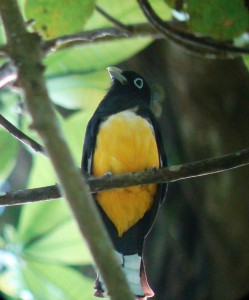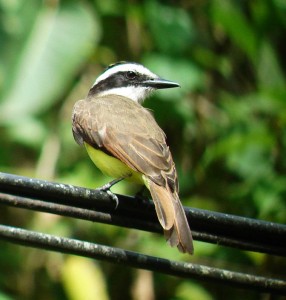“Good birding”. While some would argue that no birding is bad as along as you are watching birds, I sort of beg to differ. For example, if you sling your binos to an area that features 300 resident species yet you only manage to see 5 common, edge species that also hang out in your own backyard, referring to that “good birding” is one heck of a stretch. That would be a strange day indeed but there’s just no way that such a low blow experience could be referred to as “good birding”. Bad birding is more like it and since no one wants to experience days bereft of birds, don’t look for them in pineapple plantations, on tropical cattle farms, and in urban settings.
Those places be no home for even a fraction of the avian diversity that was historically present.
However, this post isn’t about bad birding. It’s all about good birding and in Costa Rica, one of the many places to experience happy birding days is the area in and around Carara National Park. Go there at any time of the year and there will be plenty to look at. The convergence of bioregions and habitats must make Carara a fair candidate for the top birding hotspot in the country and even Central America. I mean, this fun junction of life makes it possible to look at rainforest species like Great Tinamous and Slaty-tailed Trogon in the morning, Magnificent Frigatebirds, Brown Pelicans, and other coastal birds at lunch, and wetland and dry forest species in the afternoon. Any one of those habitats will turn up a treasure of species but put all three together and you might end up seeing 120 species in a day without a huge amount of effort.
Recently, Susan Blank and I birded some sites near Carara and the birding certainly fell into the “good” category. The original plan was to look for foothill species at El Tapir but since the forecast promised nothing but rain on the Caribbean slope, we opted for checking out sites near Carara for things like Lesser Ground-Cuckoo, Nutting’s Flycatcher, and maybe even Rusty Sparrow. To make a long story short, we didn’t see or hear any of those (which was strange for the cuckoo and flycatcher but expected for the sparrow) but constant bird action from 118 species seen and heard made up for it. This involved fairly casual birding completely outside of the park and even turned up a lifer (!); a hoped for Bridled Tern scoped from Bajamar. The looks weren’t ideal but they were good enough to finally get this summer resident as a lifer. I may need to take the ferry back and forth across the gulf of Nicoya to pick up my other potential lifer summer resident tern, the Brown Noddy.

We started the day out in moist, non-birded forest near Turrubares. The good habitat between that town and the highway was filled with the songs of Long-tailed Manakins, Lesser Greenlet, Olivaceous, Northern barred, and Cocoa Woodcreepers, White-winged Becard, Striped Cuckoo and several other expected species. No dice on Pheasant Cuckoo but that’s a very rare bird in Costa Rica in any case.
Although checking an interesting microhabitat of grassy areas with scattered trees failed to turn up Rusty Sparrow or anything of note, we had nice looks at several gorgeous Blue Grosbeaks and a tree nearly filled with Red-legged Honeycreepers.

Our next main stop was the Guacimo Road and as is usual for this dry forest hotspot, we had a bunch of nice birds. One of the first birds we saw was a distant flyby male Hook-billed Kite.

We couldn’t resist stopping to get prolonged looks at 6 Double-striped Thick-Knees in a recently plowed field.

Good looks were also had at Black-headed Trogon, several Turquoise-browed Motmots, Banded Wren, Streak-backed Oriole, White-lored Gnatcatchers, and other dry forest birds including 7 species of pigeons and doves.
Another good one was a quick look at a Pearl Kite as we drove towards the highway from Guacalillo. Lunch at a seaside restaurant treated us to great food, a welcome breeze, Mangrove Swallows, and a few seabirds (including more distant Bridled Terns).

After lunch, we decided to check the Tarcoles area for Slate-headed Tody-Flycatcher and just to see what might be around. Although the target bird didn’t show, a bunch of other fine species did including American Pygmy Kingfisher, Bare-throated Tiger-Heron, Northern Scrub Flycatcher, and Barred Antshrike.


Collared Forest-falcon! This reptilian looking bird is fairly common but amazingly adept at staying hidden even when giving its odd, moaning call.


After soaking up scoped views of the forest-falcon, we drove over to Cerro Lodge to check a small marsh near there. The Masked Duck once again evaded but it was still nice to watch the antics of Purple Gallinules, Northern Jacanas, White Ibis, see an uncommon Black-crowned Night-Heron, and a few other waterbirds.
By then, it was time to drive back up to the Central Valley with the mental satisfaction of another very good day of birding in Costa Rica.































